Continuing this week’s Trans Pride theme, below are two poems from Stacey Waite’s chapbook love poem to androgyny, winner of the 2006 Main Street Rag Chapbook Contest. Thanks to M. Scott Douglass at MSR for permission to reprint. Stacey has just won another prestigious award, the Tupelo Press Snowbound Series, for her forthcoming chapbook the lake has no saint. Put it on your Amazon wishlist today.
XY
The doctor, who speaks slowly, after spending
quite a few moments to himself in his gray office,
says there is a strong possibility I am “chromosomally
mismatched,” which cannot be determined now
unless I pay for the test, because according to
my coverage, the test is not necessary due
to the fact that I am “out of the danger zone.”
The danger zone is puberty, when, he says,
“women like me” are at risk for developing
genital abnormalities. I look back at myself at 13,
staring at my body. And I think it might have
all made sense to me somehow, if my clitoris grew
like a wild flower and hung its petals between my thighs,
which were plumping up in that adult woman way.
The doctor is careful with me, knowing how my being XY
makes me a bad example of a woman, an XY woman
is an ex-woman, whose blood has been infected by Y.
The testosterone rising like a fire in her blood.
The doctor looks mostly at his chart, he wants me to disappear,
to put back, in order, his faith in the system of things.
He wants me to react correctly, to be ashamed.
I sit nervously in the paper robe, which covers only
the front of my naked body, the cold laboratory air
drifting up through the gown, my nipples hardening
like the heads of screws. He doesn’t know he’s given
me a second chance at my body. I think about the man
I could have been. I make a list of names and settle
on “Michael” after my father, who did not love me.
I imagine the girls in my high school I would have
been able to love. Michael could have saved me
from all of this, from the sound of my voice,
from the years of wearing someone else’s skin
in the form of a church dress. Michael
is the easier version of me.
When the doctor leaves me to dress myself,
I shove his crumpled up paper gown in the crotch
of my briefs. I cover my chest with the eye chart
and try to look for Michael. But he is not able
to be seen. He is out emptying the trash at the curb.
He is in me in the way that a man is in a woman.
****
Finding My Voice
When Dr. Rosen says he can “fix my voice,” he means
he will give me shots of estrogen that will surge through
my body like electric shocks, sending the hair on my chin
and stomach running for cover. He doesn’t want me to be warm.
He doesn’t want to listen to my large truck voice
fill his office like his soy milk
bursting up from his coffee’s deep bottom.
He wants to imagine me as an affirmation.
He wants me perched upon his plastic table
with my smooth naked legs, singing hymns
in the voice of a woman who needs him
in order to recover some piece of herself
that has been swallowed by the jaws of testosterone,
opening and closing hard like the doors of angry lovers.
He doesn’t exactly know that he hates me,
the feeling is more like gender indigestion,
how the sound of my voice keeps rising
up in his throat and he can’t rid himself
of the image of my lover who stretches out
nude in the dark bed, presses her hand
above my chest saying,
“talk to me, please, talk.”
Author Archives: Jendi Reiter
New England Transgender Pride March: Photos and Reflections
The first-ever New England Transgender Pride March took place this weekend in Northampton, and I was there with my “Episcopal Church Welcomes You” rainbow tank top and a digital camera to capture the pageantry. I was hoping to blend into the MassEquality contingent, but they were scattered around other groups this time, so I just milled around looking like I knew what I was doing, and took lots of pictures. Next thing I knew, someone had handed me a bunch of purple and white balloons, and I was marching behind the lead banner, shouting “Trans Pride Now”.
Without either of my moms this time, I felt anxious that I didn’t have the right to be there. Straight allies are important, but on the other hand, was I co-opting someone else’s oppressed subculture? (I had a Native American Studies professor in college who was apoplectic about this.) The fact is, when you’re genuinely weird, and view all human social categories as potential idols to be deconstructed, the pleasures of communal solidarity are hard to come by. I have, at various times in my life, been a semi-kosher Jew and a Christian, a Republican and a Democrat, and worst of all, a Yankees fan and a Red Sox fan. I’ve argued for the Trinity to radical feminists and argued for gay marriage in my conservative prayer group. I genuinely want to be part of something with more than three members–heck, I even persuaded myself to get teary at John Kerry’s 2004 Democratic Convention speech–but until I can find the Island of Misfit Toys on GoogleMaps, that kind of surrogate family may never be mine.
So as I carried my balloons down Main Street in the blazing heat, past neighbors who undoubtedly knew I was not transgender, I felt slightly idiotic and very conspicuous. That is, until I began to imagine that actual trans people must feel this way a lot of the time, their daily lives a constant round of puzzlement and hostility from a society that doesn’t know how to categorize them. I couldn’t be trans, but I could offer up a few minutes of solidarity with their experience of social exclusion, an experience that I as a straight white woman have the privilege of avoiding if I so choose.
Whereas the main Northampton Pride March in May had a family-oriented, carnival atmosphere, Trans Pride was more bohemian and political. From their placards and speeches, it sounded like many trans folks felt they’d been sold out by the mainstream gay and lesbian activist groups, particularly the Human Rights Campaign’s decision to support the federal Employment Non-Discrimination Act even though protections for gender identity and expression had been eliminated. Some speakers seemed concerned that groups like HRC were selling a more sanitized, bourgeois image of gay and lesbian life that ignored the poor, prisoners, people of color, and those whose sexuality and gender identity defied easy labeling. Maybe I was in the right place after all.
Is being queer a state of mind? Is queerness, like Protestantism, inherently self-fragmenting, as the need for a perfectly authentic personal identity clashes with the equally real need for affinity groups? The more precisely you draw your doctrinal statement (or define your gender), the closer you get to becoming an army of one.
I noticed that a volunteer legal services group had representatives on hand to take down the names and contact information of anyone photographing or videotaping the march, so they could find eyewitnesses if there were any incidents of violence or harassment. This awareness of danger was another point of difference from the Gay Pride march. I don’t know what the hate-crime statistics are for transgender people as compared with gays and lesbians, but perhaps transgenderism feels especially threatening to people whose sense of self and social position is based on masculine versus feminine (a/k/a strength versus weakness). Gays and lesbians, for the most part, just want to be added to the list of acceptable categories, whereas trans people are undermining the categories themselves, in a very visible way. I find some support for this project in Galatians 3:28.
The photos below were taken with permission. More videos and pictures will be posted on the TransPrideMarch website in the coming days.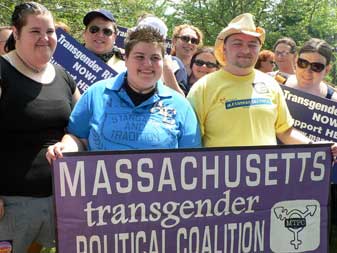
Above: MassEquality volunteer Gunner Scott (in the yellow shirt) with fellow members of the MTPC.
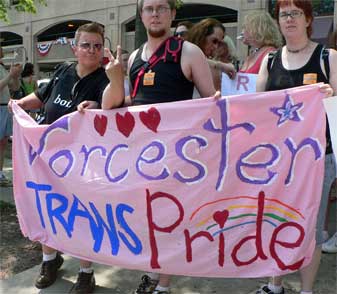

Above: Northampton’s versatile and entertaining antiwar chorus, the Raging Grannies, and other groups from the parade.
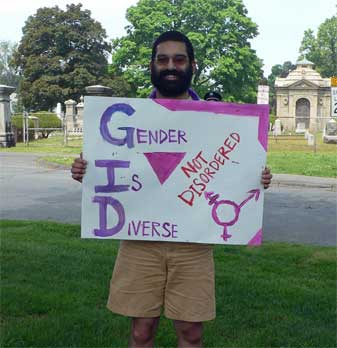
Some get the message across with words…
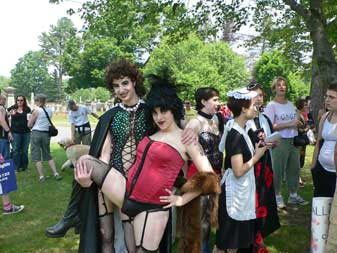
And some, just by being fabulous.

Above: Jackie Matts, one of the TransPrideMarch organizers.

This boy was so proud of his transgender mom…
…I had to capture the back of his shirt too.
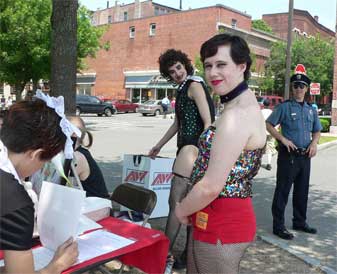
Gotta wonder what that cop is thinking.
Trans Pride Tomorrow and Other News
The first-ever New England Transgender Pride March and Rally will be held tomorrow at 11 AM in our very own Northampton, Mass. From the TransPrideMarch website:
The event is organized by members of the trans and gender variant community, and their allies, with the intent of taking a visible and positive stand for transgender rights. The March and Rally is dedicated to diverse representation among organizers and participants. We seek to educate and build awareness of the movement against gender-based discrimination.
Come join MassEquality in gathering petition signatures urging our state legislators to support HB 1722, an amendment to the Massachusetts anti-discrimination laws that would add protections for gender identity and expression.
In other news:
*Kittredge Cherry’s groundbreaking book Art That Dares: Gay Jesus, Woman Christ and More was one of five Lambda Literary Awards nominees in the LGBT Arts and Culture category. See a video of her reading from the book and telling some of the artists’ stories here.
*Soulforce has made their popular pamphlet “What the Bible Says – And Doesn’t Say – About Homosexuality” available online for free. Some key insights from Rev. Mel White:
Even heroes of the Christian faith have changed their minds about the meaning of various biblical texts.
It took a blinding light and a voice from heaven to help the apostle Paul change his mind about certain Hebrew texts. A sheet lowered from the sky filled with all kinds of animals helped the apostle Peter gain new insights into Jewish law.
Jerry Falwell believed the Bible supported segregation in the church until a black shoeshine man asked him, “When will someone like me be allowed to become a member of your congregation?” Through those simple words, the Holy Spirit spoke new truth about the ancient biblical texts to the Rev. Falwell, and in obedience he ended segregation at Thomas Road Baptist Church.
Even when we believe the Scriptures are “infallible” or “without error,” it’s terribly dangerous to think that our understanding of every biblical text is also without error. We are human. We are fallible. And we can misunderstand and misinterpret these ancient words — with tragic results.
…
****
[The story of Sodom]…is not primarily about sex. It is primarily about God. Some people say the city of Sodom was destroyed because it was overrun by sexually obsessed homosexuals. In fact, the city of Sodom had been doomed to destruction long before. So what is this passage really about?
Jesus and five Old Testament prophets all speak of the sins that led to the destruction of Sodom — and not one of them mentions homosexuality. Even Billy Graham doesn’t mention homosexuality when he preaches on Sodom.
Listen to what Ezekiel 16:48-49 tell us: “This is the sin of Sodom; she and her suburbs had pride, excess of food, and prosperous ease, but did not help or encourage the poor and needy. They were arrogant and this was abominable in God’s eyes.”…
Whatever teaching about sexuality you might get out of this passage, be sure to hear this central, primary truth about God as well. God has called us do justice, love mercy, and walk humbly with our Creator. Sodom was destroyed because its people didn’t take God seriously about caring for the poor, the hungry, the homeless, or the outcast.
But what does the story of Sodom say about homosexual orientation as we understand it today? Nothing.
It was common for soldiers, thieves, and bullies to rape a fallen enemy, asserting their victory by dehumanizing and demeaning the vanquished. This act of raping an enemy is about power and revenge, not about homosexuality or homosexual orientation. And it is still happening.
In August 1997, Abner Louima, a young black immigrant from Haiti, was assaulted by several police officers after he was arrested in Brooklyn. Officer Charles Schwarz held Louima down in a restroom at the precinct, while Officer Justin Volpe rammed a broken stick into Louima’s rectum. These two men and the three other officers involved in this incident and its cover-up were not gay. This was not a homosexual act. It was about power.
The sexual act that occurs in the story of Sodom is a gang rape — and homosexuals oppose gang rape as much as anyone. That’s why I believe the story of Sodom says a lot about God’s will for each of us, but nothing about homosexuality as we understand it today.
…
****
[Discussing 1 Cor 6:9 and 1 Tim 1:10] …To remind the churches in Corinth and Ephesus how God wants us to treat one another, Paul recites examples from the Jewish law first. Don’t kill one another. Don’t sleep with a person who is married to someone else. Don’t lie or cheat or steal. The list goes on to include admonitions against fornication, idolatry, whoremongering, perjury, drunkenness, revelry, and extortion. He also includes “malokois” and “arsenokoitai.”
Here’s where the confusion begins. What’s a malokois? What’s an arsenokoitai? Actually, those two Greek words have confused scholars to this very day. We’ll say more about them later, when we ask what the texts say about sex. But first let’s see what the texts say about God.
After quoting from the Jewish law, Paul reminds the Christians in Corinth that they are under a new law: the law of Jesus, a law of love that requires us to do more than just avoid murder, adultery, lying, cheating, and stealing. Paul tells them what God wants is not strict adherence to a list of laws, but a pure heart, a good conscience, and a faith that isn’t phony.
That’s the lesson we all need to learn from these texts. God doesn’t want us squabbling over who is “in” and who is “out.” God wants us to love one another. It’s God’s task to judge us. It is NOT our task to judge one another.
So what do these two texts say about homosexuality? Are gays and lesbians on that list of sinners in the Jewish law that Paul quotes to make an entirely different point?
Greek scholars say that in first century the Greek word malaokois probably meant “effeminate call boys.” The New Revised Standard Version says “male prostitutes.”
As for arsenokoitai, Greek scholars don’t know exactly what it means — and the fact that we don’t know is a big part of this tragic debate. Some scholars believe Paul was coining a name to refer to the customers of “the effeminate call boys.” We might call them “dirty old men.” Others translate the word as “sodomites,” but never explain what that means.
In 1958, for the first time in history, a person translating that mysterious Greek word into English decided it meant homosexuals, even though there is, in fact, no such word in Greek or Hebrew. But that translator made the decision for all of us that placed the word homosexual in the English-language Bible for the very first time.
In the past, people used Paul’s writings to support slavery, segregation, and apartheid. People still use Paul’s writings to oppress women and limit their role in the home, in church, and in society.
Now we have to ask ourselves, “Is it happening again?” Is a word in Greek that has no clear definition being used to reflect society’s prejudice and condemn God’s gay children?
We all need to look more closely at that mysterious Greek word arsenokoitai in its original context. I find most convincing the argument from history that Paul is condemning the married men who hired hairless young boys (malakois) for sexual pleasure just as they hired smooth-skinned young girls for that purpose.
Responsible homosexuals would join Paul in condemning anyone who uses children for sex, just as we would join anyone else in condemning the threatened gang rape in Sodom or the behavior of the sex-crazed priests and priestesses in Rome. So, once again, I am convinced that this passage says a lot about God, but nothing about homosexuality as we understand it today.
Read the whole piece here. The companion pamphlet “What the Science Says – And Doesn’t Say – About Homosexuality”, by Soulforce Executive Director Jeff Lutes, is also now available online.
My Story “Dinosaurs Divorce” Published on The Writing Site
My story “Dinosaurs Divorce”, an excerpt from one of my novels-in-progress, won an honorable mention in the 2007 Arthur Edelstein Prize for Short Fiction from The Writing Site, an online resource for fiction writers, and is now posted on their website. (For reasons that are not evident in this early chapter, this post is not actually a departure from our “Pride Month” theme…) Here’s the opener:
We were gypsies, we were grifters, we were untenured faculty. After I was born, my mother left her beloved Manhattan and we embarked on the wandering life of an adjunct poetry professor, which as you might expect is about as lucrative as it was in Chaucer’s day, adjusted for inflation. “And where are you from, Prudence?” Mrs. Litwin or Barone or Vasquez would chirp as I stood up before yet another elementary-school class, and I’d proudly recite, “New York and Cleveland and Durham and Lackawanna and…” I must have sounded like a train conductor.
I probably didn’t appreciate how little money Ada had. I thought we were traveling light because it was the cool thing to do. Freebird! Even her weird side jobs, I chalked up to research. Weren’t writers always supposed to be gathering life experience? (That excuse didn’t work too well when Freddy Herkimer and I cut fourth-grade math to sneak into the junior high sex-education class, however.) The most normal job my mother had was being a bank teller. She told me her hero T.S. Eliot had also worked in a bank. I was about seven then, so we must have been in North Carolina, and at first I thought she was talking about Eliot our pet parrot. He must have had an interesting life for a bird, but how could he process the deposit slips without any fingers? Ada thought this was really funny and told all the girls at the bank, which annoyed me, and annoyed her even more when they didn’t know who T.S. Eliot was. The next year we moved to Buffalo and she signed up to sell bootleg T-shirts at Goo Goo Dolls concerts.
When winter put an end to the concert season, Ada somehow managed to get a job in the university chem lab, although she knew nothing about science. The professor was this old Southern guy who was always licking his lips and smoothing his hair back. I think he liked her legs. I grew to associate the smells of acetone and lab gloves with my mother’s goodnight kiss and the stories she told me at bedtime.
Read the whole story here.
Carl Phillips: “The Point of the Lambs”
Carl Phillips is a professor of English and African and African-American Studies at Washington University in St. Louis. His poetry has received numerous honors including the Kingsley Tufts Award, an Academy of American Poets Fellowship, and a Guggenheim Foundation fellowship. The poem below is reprinted by permission from his collection Quiver of Arrows: Selected Poems, 1986-2006.
The Point of the Lambs
The good lambs
in the yellow barn–the rest
housed in blue. By
“the rest,” meaning those who
–the guide explained–inevitably
arrive suffering. For
some do, he added.
Soft.
Serious. This–like
a new lesson. As to
some among us, it was,
it seemed. The usual
stammer of heart the naive
tend to, in the face of what finally
is only the world. What
must it be, to pass
thus–clean, stripped–
through a life? What
reluctance the mind
shows on recognizing
that what it approaches
is, at last, the answer
to the very question it knows
now, but
too late,
oh better to never to have never
put forward. What I
mean is we moved
closer,
in,
to the blue barn’s
advertisement–
flaw,
weakness. We
looked in.
Three days, four days
old. Few expected to
finish the evening it was beginning to
be already. And the small
crowd of us
shifting forward, and–
in our shifting uniformly–it
being possible to see how between
us and any
field rendered by a sudden wind
single gesture–kowtow,
upheaval–there was
little difference. Some
took photographs; most
did a stranger thing: touched
briefly, without
distinction, whichever
person stood immediately in
front of, next to. Less
for support than
as remedy or proof or
maybe–given the lambs who,
besides dying, were as well
filthy (disease,
waste and, negotiating
the dwindling contract
between the two.
the flies everywhere)–
maybe the touching
concerned curbing the hand’s instinct
to follow the eye, to
confirm vision. Who can
say? I was there–yes–but
I myself touched no one.
Janet Aalfs: “Facing the Wall”
Janet Aalfs is a former Poet Laureate of Northampton and the director of Valley Women’s Martial Arts. Her poetry collection Reach was published by Perugia Press in 1999. The poem below is reprinted with permission from her chapbook Full Open (Orogeny Press, 1996).
Facing the Wall
1. Someone found a heart
on market street not human
there’s really no cause
for alarm though a naked heart
warm on the sidewalk on halloween
is upsetting but not as bad as if
it were the organ of a valuable life
we don’t mean
one of the seventeen women found
strewn along desert highways
you can’t question whores their stories
aren’t reliable their lives aren’t stable
the reason we haven’t found a suspect
yet is that we can’t
get a straight answer out of anyone
and no one really knows
a slut she’ll go with whatever man
will take her you can’t trust women
like that to die when they’re supposed to
with their clothes on at a legal address
we think we’ve discovered the eighteenth
2. I want to know why
the fbi is so good at tracking down
bank robbers twenty years later charging them
with attempt to overthrow the government and
if the killer were out to slaughter corporation
presidents they’d nab him before he stepped
into the first lobby but they can’t find
a guy who hits on women one after the next
leaves them stripped to the bone
returns to his car job tv neighbors
like whoever left the heart on market street
now floating pickled in a hospital jar
silent as the eighteenth woman tagged
in a numbered refrigerator drawer no name address
important as she ever was
I want to know how that heart
arrived at market street who cut it out
of what body I want the names of every
thrown-away life engraved on a shiny
black wall then no one will be able to stand
anywhere in the world and not face it
Melanie Braverman: “Tell” and “Fantasia”
Since 1997, independent poetry publisher Perugia Press has been supporting women at the beginning of their publishing career. Based here in Northampton, this proudly lesbian-owned press publishes one book a year through their poetry manuscript contest for a first or second book by a woman. Their books are handsomely designed and well-promoted. Below, reprinted with permission, are two poems from Melanie Braverman’s collection Red, which won their 2002 contest. Read more of her work here. Later this week, I’ll be reprinting a poem by another Perugia author, Janet Aalfs, from her chapbook Full Open (Orogeny Press, 1996).
Tell
Let’s talk
about sex, let’s talk about what
you like to do, or have
done to you, or do to
yourself while someone else
is watching, say
you like it in cars, while you’re
driving, maybe, his hands or her
mouth between your legs, or in
a basement, quiet except
for the sound of your
breathing, which is
getting
faster, you
can’t
help it, you like
the way the air fits your skin like another
skin, the air and her breath or just
her breath, you can’t tell
anymore but you like
it, you do, you’re a little
scared even though you’ve done
this with him before, you’ve known
him for years, or maybe you
just met, at a bar, in the library, on
the street in the fog, walking
the pier at two A.M., admiring the boats, the birds
quiet
mostly, the aqua the red
beam from the light
house pulsing so you feel
your blood the way
it wants you to feel
it, you see
that man walking just
ahead of you, the woman
whose arms are swinging at, you
swear, the same
cadence as your own, my god, she
has an amazing ass, it’s round or
small, whatever
kind of ass you like that’s
it, moving in front
of you like a beacon, like
an offering, forget
every bad thing that ever
happened to you, forget
danger, have faith
in your own safety now, speed
up and tell
that man hello, he wants
you to, maybe
you like it at home, in your own
bed or at his house, the way someone
else’s sheets feel like little
revelations across your back when she lifts
your shirt off and you
finally lie
down, after all
that kissing, your faces
rife with it, his
breath
and his rough
cheek or her
cheek smooth as sin there, her foreign
breath, or maybe she’s so
familiar her breath
has come
to smell
like your own, you’ve fallen into bed exhausted
with the one you love and still something
in you stirs, your body rises
now, as if sex with this
person has become
part of your dream
life, talk
about that, the mysterious, the absolute
way you fall in-
to or out
of yourself, toward
another, toward that orange
place where anything
can happen or will and know
you’ll
like it.
****
Fantasia
One week before Halloween the heterosexual
men dressed as women haunt our streets, handbags
slung across their thick wrists like those
IV poles the chronically infirm are forced
to walk around with looking
eager, hopeful, necks rigid
as spars to keep their impeccably
coiffed wigs from falling like sails askew in the harbor’s
wind, tastefully
accessorized because for a week at least they don’t
want to be bankers and miscellaneous middle-
management professionals, they want
a life in which the only meal they have to show up
for is lunch, and after that shopping, or a game
of bridge or, better yet, hearts, they want
to sit for a week in the front
windows of our cafes eating triangular-
cut sandwiches, tipping and expecting
attentive service from the gay
men and lesbians who serve them. This year the heterosexual
men dressed as women appear
to have faith that we will not think less
of them as women if they, by day, forego their stringent four-
inch heels, we are seeing an upsurge
of Keds in feminine colors: fuchsia, tomato, baby
blue, spring
green, with pointy
elongated toes. Perhaps they have been following
some cultural timeline so that now
in their imitation they have entered the moment of women’s
liberation, not
the sixties, these men would never burn
their bras, they believe
in foundation garments the way they must, in their real
lives, believe
in the appropriateness of smaller
government; no, for them it is the early
seventies, when even upper-middle-class
ladies took off their aprons and began the daily
scandal of wearing
pants, not pantsuits or slacks but the heartier fabrics once
intended only for husbands–denim, corduroy, serge, pants
that did not zip up the side, or like straight-
jackets close up the small
of the back, an era in which these men themselves might have left
their wives who are walking toward us now in Beech
Forest, their husbands slightly behind them with gingham
kerchiefs covering their voluminous artificial hair, picking
their way gingerly down the leaf-strewn path
toward my girlfriend and me, who have been speaking
in low voices about our love, how once we found
each other it seemed wrong-headed to turn away,
even when it meant hurting others, and how
unwomanly that was, and what it could mean
to never be forgiven.
Pride Month at Reiter’s Block
June is Gay-Lesbian-Bi-Transgender Pride Month. Why do I care? Perhaps some of you have been wondering why a straight, married woman has such a queer blog. There are several reasons why this issue has become my particular passion.
On a personal level, I was parented by two women, and experienced firsthand how homophobia among our relatives and neighbors cut us off from an essential support network. When you can’t even admit that you are a family, you can’t ask your teachers or friends for help with family problems, which then are compounded by shame and isolation. Growing up with two very different women also taught me that there were diverse ways of being female. You could wear eyeshadow and long flowing blouses, read Victorian children’s stories, pretend to be a flamenco dancer, and swear like a longshoreman. You could wear motorcycle jackets, pump your biceps, and cook gourmet French meals. So naturally, at the age of six, I decided I wanted to be a pirate king. I still do.
There’s a scene in the Quentin Crisp bio-pic “The Naked Civil Servant” where an army recruiting officer is haranguing the young cross-dresser with the verse from Genesis, “Male and female created He them.” John Hurt, as Quentin, responds with an unflappable smile, “Male and female created He me.”
That’s how I feel, as an artist and a person who happens to have two X chromosomes. Until I discovered the notion of gender as performance, I thought I was an inadequate woman because none of the standard feminine archetypes fit me comfortably. Or rather, they all fit somewhat, and I didn’t want to choose between them. (This explains why my wardrobe is half man-tailored striped shirts and half hot-pink spandex.) Little princess, country wife, brainy girl, sexpot, corporate bitch. They’re all fun part-time, impossibly confining otherwise. Gender is like genre. When we live in subjection to a formula, it makes our art untrue.
Actually, before I got married and started using my body for something other than getting from place to place, most of the time I wanted the world to engage with me as pure mind, pure personality, a unique individual rather than a sexual stereotype. In other words, I wanted to be…a man. (Yeah, I blame the patriarchy. But it makes me hot, too.)
The point is, each of us is far more complex than a binary opposition or a set of costumes. It’s a lucky accident that I, being attracted to men, wound up in a female body. For the most part, our society now recognizes that such accidents should not determine whether I can go to school, give testimony in court, own property, or hold a job. Surely the opportunity to love another person, and seek social support to keep that love faithful and healthy, is more important than any of these.
So GLBT issues are my issues, as a subset of the feminist project of setting both men and women (and everyone in-between) free to relate to one another as fully human individuals, not as projections of a dominant group’s fears and fantasies.
My most important reason, however, is theological. Christian opposition to gay relationships is founded on a way of reading the Bible that I find legalistic and self-deceptive, with consequences that go far beyond this issue.
Let me say that I know devout Christians who are on the other side of this debate, who bear no hostility toward GLBT people and are genuinely pained that they have to preach the hard word of self-sacrifice and celibacy to this community. Liberal rhetoric about “compassion” and “fairness” misses the point because conservatives rightly elevate the Bible above secular political values. The latter group of Christians are also trying to be compassionate and fair, at least sometimes, but they’re convinced that their reading of texts like Romans 1:26-27 is the only one that properly maintains the Bible’s authority.
In practice, however, this means shielding the Bible from outside information (historical, scientific, literary, or psychological) that might force us to reinterpret the apparently “plain” meaning of the text. Information such as: Are today’s gay and lesbian partnerships different from the same-sex practices St. Paul was criticizing–as different, in some cases, as today’s heterosexual marriage is from prostitution and child abuse? From a Christian standpoint, is the relevant fact about Hellenistic sexual practices the gender of the participants, or their unequal power relations and connection to idol worship? If St. Paul condemned these acts because the science of his day considered them “unnatural”, should we change our valuation based on the growing evidence that homosexuality is an inborn and unchangeable trait, not a mere lifestyle choice?
Conservatives fear that these other sources of knowledge will displace the Bible, such that we begin judging and rejecting Christian beliefs based on their conformity to some secular ideology, rather than a Christ-centered worldview. As the spread of Enlightenment skepticism into liberal churches shows, this fear has some foundation.
However, the so-called literal interpretation is no less based on empirical data not found in the Bible–everything we know, or think we know, about the situations to which the Bible is being applied. There is no interpretive formula that can magically elevate the Bible to a pristine ahistorical position above the risks and responsibilities of applying it to an ever-changing and mysterious world. To believe otherwise is an insidious form of being our own savior, thinking we can get it right once and for all, and never have to listen to the Holy Spirit again.
By refusing to take in any wisdom from our own cultural moment, however imperfect (like all cultural moments) it may be, we only end up idolizing the cultural moment of 2,000 years ago, including all its scientific mistakes and arbitrary prejudices. Human history didn’t end there. Perhaps God had a good reason for that?
I recently took a psychological evaluation true-false test on which one of the questions was, “I know who is responsible for all my problems.” (The fact that I giggled at this one will probably count against my sanity assessment.) Something in our status-conscious primate brain is powerfully attracted to this statement. As theologian James Alison has written, the Christian message of universal sinfulness and unmerited grace constantly chafes against our instinct to shore up our selfhood by choosing a scapegoat. Jesus became the ultimate scapegoat in order to relativize all these systems of dominance. Compared to the gap between his perfect innocence and our culpability, any distinctions of merit among us are trivial. By forgiving us, he gives us a significance more real than anything we could establish by comparing ourselves to others. And that, my friends, is what upholds the authority of the Bible. Jesus–nothing more and nothing less.
Videos from Spring Open House at Writers in Progress
Last week I read from my novel-in-progress with several very talented women who were fellow alumnae of Dori Ostermiller’s Writers in Progress workshops in Florence, MA. My husband taped the performances on his new “Flip” camera, which are linked below for your viewing pleasure. Each segment is about 10-15 minutes, except for the intro, which is shorter.
Introduction by Writers in Progress workshop leader Dori Ostermiller:
Dusty Miller recounts a budding attraction between two young feminists, one of whom has a terrible secret:
Kate Kahn reads a poignant short story about a young woman in a 1950s trailer park who hopes for a better life:
Stephanie Faucher reads from her forthcoming young adult fantasy novel about a girl who discovers a magic book:
Don’t Take Your Breasts to Church
Clothing signifies who we think we are and where we belong in the social order, so it’s no wonder that religious communities have long been preoccupied with dress codes. While I do believe there is such a thing as dressing appropriately for an occasion, I struggle with how that issue becomes entangled with policing women’s sexuality.
To put it bluntly, women’s clothes are sexually coded in a way that men’s are not. Outside of beaches and nightclubs, men rarely wear anything provocative or revealing when they want to dress up. Men can wear a straightforward, professional suit to any special occasion, without worrying that they are sending the signal that they no longer think of themselves as young and desirable.
By contrast, women’s formal wear is all about sexual display. High heels, short skirts, makeup, low cleavage, rich fabrics, and form-fitting clothing are meant to show that a woman is toned, young, sexually confident and worth looking at.
Standards are also more lenient for men. Basically, all they have to do is shave, put on a clean shirt with no logos on it and match their socks correctly, and their wives and mothers breathe a sigh of relief as they settle into the pews.
Women’s clothing involves many more subtle, confusing gradations of formality, trendiness and sensuality. This variety certainly makes it more fun as a potential vehicle for self-expression, but it also opens us up to be judged more harshly according to ever-shifting standards.
Mixed messages about our clothing reflect the culture’s difficulty integrating the spiritual, physical and emotional aspects of womanhood. We learn, through the fashion choices available to us and their representation in the media, that being a strong, vital, self-confident woman includes proudly expressing our sexual nature. But suddenly, when we arrive in church, people have a whole lot of opinions about whether our lipstick is too red or our neckline is too low.
This can feel like a commentary on more than our fashion sense. In a cultural context where our strength, our value and our sexuality are enmeshed, unequal scrutiny of male and female fashions makes me worry that I’m capitulating to patriarchal theology when I put on a long skirt to visit my friend’s evangelical church. I just want to hear the gospel. Leave my ankles out of it.
Some of us, thanks to God and Herrell’s Ice Cream, are built such that anything tighter than a muu-muu will look provocative. I spent too much of my adolescence wearing granny dresses because I was afraid to attract sexual attention from rude, immature boys. Around my peers, who were sexually precocious and dressed accordingly, I felt like a little girl among grown-ups. No matter how smart you are, no one takes you seriously in Laura Ashley. You’re quaint, like a parrot who can sing the Marseillaise.
Now I’m a mature woman and I want to dress like one. This includes choosing clothes that flatter my figure and express my physical confidence. High-necked shirts make me look like a sack of potatoes. Beyond that, it takes a lot of effort to find age-appropriate, non-frilly clothing that would satisfy the conservative Christian dress code. A woman in her thirties who wears mother-of-the-bride dresses is sending a strong signal that she understands herself to be too old or too shy to be thought of as a sexual being. My booty is not ready for the rocking chair.
Meanwhile, in my liberal church–of course!–anything goes. Do I wish the teenage acolytes wouldn’t wear sneakers under their robes? Sadly, I do. Church clothes should be different from casual clothes for the same reason that the priest wears vestments: to demarcate a sacred time and place, set apart from the world’s business. Am I upset that the tanned, toned young girls sport belly-baring shirts? Only because I’m jealous that I didn’t look like that at their age, and now it would be ridiculous.
Women, let’s be honest about our anxieties about other women’s clothing. This is an area of competition for us. Sexuality is often a proxy for status, authenticity, and confidence. Some of us might like church to be a “safe space” where we get a break from fearing that someone else looks stronger, younger, or more successful. But such judgments can make the space feel unsafe for other women who find interpretations placed on their clothing against their will.
I don’t have a simple rule to solve this problem. Some would say that a certain dress code is part of the package, and if you don’t like it, don’t go to that church. Personally, I don’t see what sola scriptura has to do with polyester print dresses. We give in too easily to the cultural captivity of the gospel. Can we find a way to preserve the reverence of “putting on our Sunday best” while being critically aware of unequal pressures on men and women?